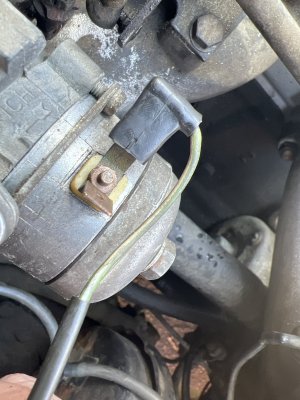On the relay, my 3.0 does not have such a relay, but it does not have air auxiliary valves neither
carbs are of several different versions
carbs are of several different versions
After following Hb Chris’s instruction I adjusted the water choke. The car was harder to start, but while it warmed up it now idles at 1200 rpm, when it reached operating temperature the idle climbed back to 2000 and stayed there!Maybe you know how the automatic choke works.
this engine requires a curious sequence to start well
The first thing you should do with a cold engine is to check the carburetors.
When the engine has cooled from its hot normal function you should be able to see the two primary buterflies of the two carburettors fully open.
if then (with the engine off) you press the accelerator only once, both throttles should close at once like a mouse trap
After following Hb Chris’s instruction I adjusted the water choke. The car was harder to start, but while it warmed up it now idles at 1200 rpm, when it reached operating temperature the idle climbed back to 2000 and stayed there!
I shut the car off and pressed the pedal but the chokes did not snap shut
Ok I will wait for it to cool and try againfollowing that instruction you did not adjust the water choke but the tension of the bimetallic spring that operates the primay buterfly (maybe in your case it was too loose)
as you did not tell all the details it is hard to follow
when engine is still warm the pedal will not shut the buterflies
i think that you should follow the procedure from cold engine now to see how it works, take pics and notes)
Those are green/white dot, I would leave them alone without the relay. You must still have power to the green/white stripe or your car won’t run.S
interesting, I didn’t know that. What about the two cut green and white wires in one of my previous pictures, reconnect??
You mean these green and white?Those are green/white dot, I would leave them alone without the relay. You must still have power to the green/white stripe or your car won’t run.

I just disconnected all wires to solenoid and carb and the car still starts up and rune, how can this be?If it goes to the idle valve key must be on for it to energize and open the valve or car won’t run, period
Tell me about it, I feel like I am chasing my tail here.Wow, I’m stumped.
Ok I will wait for it to cool and try again
Thanks for trying to help I appreciate it
 e9coupe.com
e9coupe.com
 e9coupe.com
e9coupe.com
Tell me about it, I feel like I am chasing my tail here.
Soon I will be putting an m90 with a dogleg in the car, but until then I wanted to drive the car
